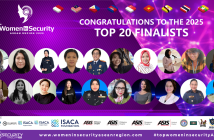A flash flood changed Kate Fitzgerald’s career direction and now the emergency management professional is looking at how we can mitigate future risks.
When Kate Fitzgerald left school she enrolled in veterinary science. It was a flash flood—not quite a sea change—in her Wollongong neighbourhood that took her on a completely different career path. “I remember walking around the area seeing houses destroyed. That event made me really interested in natural disasters and emergency management, even though I didn’t know it was called that.”
The spark of interest turned into a volunteer stint at the NSW State Emergency Service (SES) where she met a commander who was completing a degree in emergency management at Charles Sturt University. Fascinated, Fitzgerald inquired about enrolling, then changed her degree.
Now she works in Relief and Recovery Operations at Emergency Management Australia (EMA), a division of the Attorney-General’s Department, looking after the Natural Disaster Relief and Recovery Arrangements program, which assists with recovery efforts.
Summer is understandably the organisation’s busiest time with a range of possible disasters on the radar: from bushfires to cyclones and floods. The team needs to be ready to activate response and recovery support as well as deal with the political aspects that accompany a major incident. The organisation’s scope also covers terrorist events. In winter it’s about ensuring recovery efforts stay on track and reflecting on the effectiveness of the previous season’s work practices. “We work primarily in the recovery space. Some of the work we do within the recovery space may then flow into a community becoming more resilient or more prepared for the season ahead,” says Fitzgerald.
A global calling
But Fitzgerald’s career was not always Canberra-based. In her early 20s she lived and travelled around Europe for four years while undertaking her degree by distance education. After the traditional rite of passage working in bars, she landed an administration role in the emergency department at Dublin’s St Vincent’s Hospital, which evolved into Fitzgerald contributing to its evacuation and crisis planning, bringing her education to life.
When she returned to Australia in 2008 she took on a three-month contract role with EMA to deliver a conference. In 2009, the Victorian bushfires turned that conference producer role into a substantive longer-term position helping to coordinate the offers of international assistance. Meanwhile, she had begun studying her Master of Emergency Management by distance, again through Charles Sturt University.
For two years, Fitzgerald worked in the EMA office before the department was restructured, then moved into the National Security Capability Development Division. “I worked in a range of roles there. I was still in the emergency management sector, but managing mitigation, funding programs, and things like that.”
That led to a yearlong stint in Prime Minister and Cabinet (PM&C) as an emergency management adviser within the National Security Division. “We had a number of significant disasters while I was at PM&C, the Queensland floods and so on. I was involved in providing advice to the Prime Minister and to the government on the emergency management implications of those disasters,” says Fitzgerald.
She returned to EMA as an executive officer to a Division Head for a period of time before being offered a scholarship through the US Congress-funded Asia-Pacific Leadership Program at the University of Hawaii. “It was a 12-month program and I lived in Hawaii for six or seven months. While I was there I focused on emergency management and worked with people from around the Asia-Pacific area. There were about 30 of us from 20 countries. It was pretty diverse both participant-wise and also what we focused on, which was part of the attraction for me.”
Fitzgerald chose risk management, sifting through research conducted by the World Economic Forum on the impacts of the interconnectedness of global risks. During the program, Hurricane Sandy hit the east coast of the USA and Fitzgerald was deployed with the American Red Cross to assist.
Practical in an emergency
It wasn’t the first time Fitzgerald had lent a hand to a recovery effort. Her volunteer work with the SES in Wollongong involved repairing roofs and heading out in a boat to provide assistance. Since then, she’s been doing practical training alongside study. “I got that ethos from my family, just going out and helping my community. I got a lot of great training experiences, learnt a lot about team management and leadership.”
It served her well, too. After her undergraduate degree she realised the qualification wasn’t enough on its own. “What I underestimated was the importance of both experience and practical application,” says Fitzgerald. “I wouldn’t have got to where I am today without having volunteered, and I also feel that I wouldn’t be as effective at my job without my volunteering experience, without keeping a finger on the pulse about the real concerns and issues of people that are impacted by disasters.”
Even in Ireland she volunteered with Civil Defence, an organisation like the SES, then when she settled in Canberra she joined the ACT Rural Fire Service and the Australian Red Cross Emergency Service, which she’s served for more than five years.
“I was a bit nervous about joining the Rural Fire Service because I thought it was a macho environment, but it has been one of the most welcoming environments I’ve ever volunteered or worked in,” she describes. “It has been nothing but supportive about more women coming in.”
The operational sector is male-dominated, she admits, but the emergency management industry as a whole, including research, mitigation and planning, policy and administration governance, has a roughly 50/50 gender split.
“AIIMS [Australasian Inter-Service Incident Management System] has a military command-and-control structure, so that tends to be a masculine leadership style,” Fitzgerald explains. “When you move into the recovery space you’re dealing with complex, long-term problems which are centred primarily around providing social support to the community. You tend to find women working in those community service roles, traditionally.”
The macho stigma simply comes from the media attention, which is usually focused on the more newsworthy ‘response’ part of an incident. Fitzgerald says emergency management is actually quite an equitable environment. “My very early experience was my SES unit, which was about 50% women, 50% men. The fact that I was a woman was never really an issue. I think that’s just something I’ve been particularly blind to for most of my career.”
Modern risks
Volunteering has also informed her studies. Her research-based master’s focused on volunteering within the emergency management sector, which helped her develop a national risk framework for Australia based on comparable frameworks from the USA, New Zealand and the UK. Fitzgerald says it was a catalyst for the leadership positions she then secured. “It really made me think strategically about how issues within emergency management are connected and addressed and moved my career direction away from that operational focus to a broader strategic focus across the PPRR [prevention, preparedness, response and recovery] spectrum of emergency management.”
This all funnelled into the Asia-Pacific Leadership Program where the threefold benefits were building her leadership skills, reaffirming her passion and direction within the emergency management sector and networking across different countries and cultures.
“I got fantastic exposure to some of the work that’s going on, in both a regional and international sense, on risk management,” she says. “I was lucky to do the work with the World Economic Forum looking at global risks and developing methodologies for workshops within the region on future thinking: identifying and mapping those futures and then identifying the risks within those environments and how countries and governments can prepare for those future risks.”
One future risk she’s particularly interested in is the risk of modernity, which she covered in a presentation at the Australia and New Zealand Disaster and Emergency Management Conference earlier this year. Using Ulrich Beck’s World at Risk as a starting point, Fitzgerald spoke about how society’s over-reliance on technology—such as electricity and telecommunications—can exacerbate the effects of an incident.
Hurricane Sandy showed Fitzgerald what the risks of modernity looked like. Response issues quickly transitioned from providing basic needs, such as food and accommodation, to the consequences of modern society, she reports. “The American Red Cross personnel weren’t able to communicate with each other. They had no radio infrastructure, as they were entirely dependent on being able to communicate by mobile phone. They hadn’t prepared for or anticipated the complete failure of the telecommunications system.”
It’s not all disaster and firefighting for Fitzgerald, however. In between her day job, volunteering and other roles, including lecturing on decision-making as part of the CSU course, she keeps active with sport, playing tennis and netball, and travels to see family members who live on the coast, as well as those in Ireland.
But even she admits she can’t get enough of emergency management, with plenty of passion left in the tank. “I can’t ever imagine working in another sector, so I don’t have a lot of spare time. I’m either volunteering or reading something about it. You really do get to see on a very tangible level your ability to be able to assist following a disaster.”





